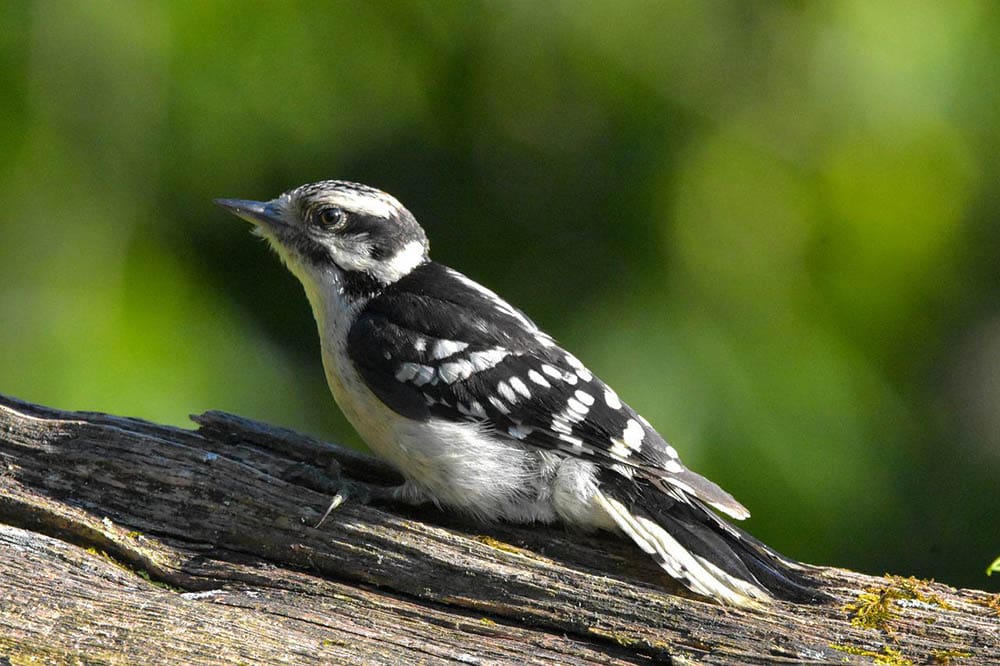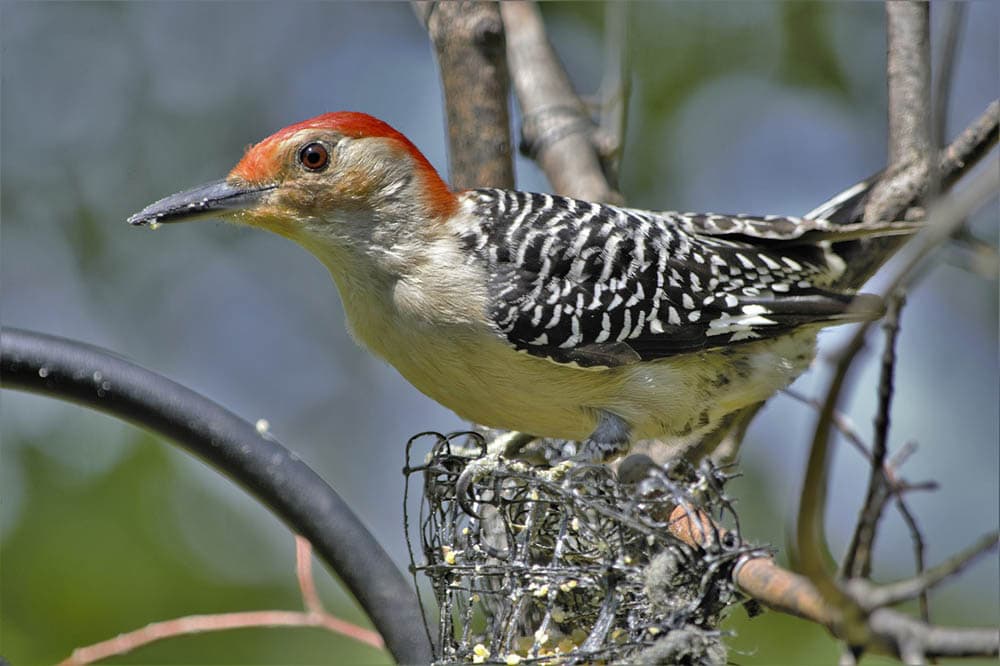7 Species of Woodpeckers in Missouri (with Pictures)
Last Updated on

Woodpeckers are one of the most interesting bird species in the United States. Not only are they noted for their signature wood-drumming sound, but they also stand out easily due to their narrow, elongated beaks and unique feather patterns. If you live in the state of Missouri, you may regularly come across these beautiful birds in your backyard, at a local park, or on a running trail.
When in your backyard, you’ll likely find them looking for food by pecking holes in excavated tree trunks, one of the most unique characteristics of their daily behavior. Many of these birds love to hang around the state all year round due to the mild weather, though many will flock to the south for a bit of warmth and food provisions.
They typically forage on small insects, fruit, birds’ eggs, tree sap, and human discarded food. Woodpeckers are a part of the Picidae bird family, which also includes, sapsuckers, piculets, and wrynecks. Here are seven common Woodpecker species found in Missouri.

The 7 Species of Woodpecker in Missouri
1. Pileated Woodpecker

| Scientific Name: | Dryocopus pileatus |
| Length: | 15-19 inches |
| Wingspan: | 25-30 inches |
Pileated Woodpeckers are commonly found in Missouri and are one of the largest birds of the woodpecker species. They almost resemble small crows except they have distinctive black and white feathers and a red tufted hood (similar to that of the Northern Cardinal). These woodpeckers can be seen munching on beetle larvae, nuts, flies, ants, and other small insects.
Their long, sharp beaks allow them to easily peck through deadwood to find food sources. They are common in open areas with extensive forests. You may see them in your backyard if you have lots of tall trees or a bird feeder. These woodpeckers are beautiful to watch and have a unique woodpecker drumming and call.
2. Yellow-Bellied Sapsucker

| Scientific Name: | Sphyrapicus varius |
| Length: | 5-8 inches |
| Wingspan: | 5-21 inches |
This medium-sized woodpecker is known for its beautiful yellow underbelly, though it has mostly black and white feathers. Both females and males have red crowns, and males also have a red-feathered throat. These birds can be found hanging out in local parks, forests, or open plains with lots of tall trees.
Though they are popular in Missouri, you can also find them in neighboring Midwest states as well. The Yellow-Bellied Sapsuckerloves to drill holes into maple trees and drink sap (thus the nickname) but they also enjoy snacking on wild nuts, insects, fruit, and berries. They’ve become a protected species and can usually be seen around Missouri in the spring up until the late fall and winter months, which is when they typically migrate south.
3. Red-Headed Woodpecker

| Scientific Name: | Melanerpes erythrocephalus |
| Length: | 3-9 inches |
| Wingspan: | 13-14.6 inches |
The Red-Headed Woodpecker has similar colors to its red-bellied cousin. They also have white bellies and red heads, but their wings are solid black with a thick white stripe in the middle. They’re medium-sized birds of average length and wingspan. You may find them in the forest munching on wood from dead trees, though they also love to eat acorns, insects, and other birds’ eggs.
The species has actually been declining in recent years due to a lack of adaptation to more modern areas. However, you may be able to spot them in your backyard or perched on tree branches on local trails. This woodpecker species tends to migrate south for warmer temperatures and extra food, and the best times to spot it is in the summer and spring months.
4. Red-Bellied Woodpecker

| Scientific Name: | Melanerpes carolinus |
| Length: | 5 inches |
| Wingspan: | 14-18 inches |
The Red-Bellied Woodpecker surprisingly doesn’t have a red belly. It is typically white but may have a hint of rust-colored feathers leading toward its throat. These small, stocky woodpeckers are known for their beautiful black and white striped feathers and their red heads and napes.
You’ll typically find this species around Missouri throughout the year, and they can commonly be seen in open woodlands and local forest preserves. You can attract them to your backyard by laying out a simple feeder with nuts, fruit, and seeds. They have a very distinctive call, which you can hear during the spring and fall months, as they look for mates and signal for food sources.
5. Downy Woodpecker

| Scientific Name: | Dryobates pubescens |
| Length: | 4-6.8 inches |
| Wingspan: | 29-4.1 inches |
The Downy Woodpecker is one of the smaller birds of the species. This particular bird has a white belly with black and white striped feathers and a distinctive red patch on the back of its head. They have a short, stocky build and are usually perched on small branches or hanging out on the ground foraging for insects, wild nuts, and fruit.
You may see them in your background or any open woodland area that has wild nuts, seeds, or a suet feeder. Their small size allows them to quickly trot along branches and across the grass to find food sources. After seeing them a few times you may recognize them more easily by their distinctive walk and surprisingly high-pitched call, which also makes them stand out from other woodpecker species.
6. Northern Flicker

| Scientific Name: | Colaptes auratus |
| Length: | 11-13 inches |
| Wingspan: | 19-21 inches |
The Northern Flicker is another woodpecker commonly found in Missouri. They are noted for their spotted gray and black feathers and the small red spot on the side of their beak. Overall, they have a large round body with strong, long beaks. Their tail is brown, and they have a rather expensive wingspan of about 20 inches.
When they are in flight, you may also notice the gorgeous yellow feathers on the underside of their wings. Pedestrians will often hear them drilling their way into deadwood while visiting local forest preserves or state parks. You may not see them in your backyard as often, as their numbers are declining. Their diet consists mostly of small insects such as ants, spiders, and flies, but they also munch on seeds and nuts as well.
7. Hairy Woodpecker

| Scientific Name: | Dryobates villosus |
| Length: | 6-10 inches |
| Wingspan: | 13-16 inches |
Hairy Woodpeckers are often mistaken for Downy Woodpeckers, as they have a similar build and feather pattern. However, Hairy Woodpeckers are a bit larger than Downys and their beaks are significantly longer. You may also notice that their tail feathers are a bit more rigid, which may explain their interesting nickname. They also have similar behavior patterns to Downy Woodpeckers and can easily climb trees and trot along grass and branches to find food. Their diet is pretty much the same, as they also love to munch on small insects for the most part, but will also eat seeds, fruit, and suet from feeders.

Conclusion
If you’re a Missouri resident and an avid bird watcher, you should definitely keep an eye out for woodpeckers in the Missouri area. And if you live in a suburban or open area with plenty of trees, it shouldn’t be hard to find their distinctive sound and their noticeable feathers will usually be a dead giveaway.
You can sit out a feeder with suet, small pieces of deadwood, or fruit to attract them. You will, however, want to be cautious of inviting this bird species to your backyard, as they can seriously damage trees and other wood structures.
See Also: 15 Common Types of Sparrows in Missouri (With Pictures)
Featured Image Credit: JackBulmer, Pixabay
About the Author Robert Sparks
Robert’s obsession with all things optical started early in life, when his optician father would bring home prototypes for Robert to play with. Nowadays, Robert is dedicated to helping others find the right optics for their needs. His hobbies include astronomy, astrophysics, and model building. Originally from Newark, NJ, he resides in Santa Fe, New Mexico, where the nighttime skies are filled with glittering stars.
Related Articles:
Monocular vs Telescope: Differences Explained (With Pictures)
10 Types of Hummingbirds in Arkansas (With Pictures)
8 Types of Hummingbirds in Nebraska (With Pictures)
5 Types of Hummingbirds in Idaho (With Pictures)
3 Types of Hummingbirds in Mississippi (With Pictures)
8 Types of Hummingbirds in Kansas (With Pictures)
5 Types of Hummingbirds in West Virginia (With Pictures)
5 Types of Hummingbirds in Ohio (With Pictures)
